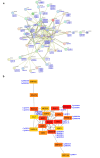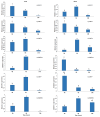Identification and characterization of the Quinoa AP2/ERF gene family and their expression patterns in response to salt stress
- PMID: 39604476
- PMCID: PMC11603269
- DOI: 10.1038/s41598-024-81046-1
Identification and characterization of the Quinoa AP2/ERF gene family and their expression patterns in response to salt stress
Abstract
The APETALA2/ETHYLENE RESPONSIVE FACTOR (AP2/ERF) transcription factors play crucial roles in plant growth, development, and responses to biotic and abiotic stresses. This study was performed to comprehensively identify and characterize the AP2/ERF gene family in quinoa (Chenopodium quinoa Willd.), a highly resilient pseudocereal crop known for its salinity tolerance. A total of 150 CqAP2/ERF genes were identified in the quinoa genome; these genes were unevenly distributed across the chromosomes. Phylogenetic analysis divided the CqAP2/ERFs into five subfamilies: 71 ERF, 49 DREB, 23 AP2, 3 RAV, and 4 Soloist. Additionally, the DREB and ERF subfamilies were subdivided into four and seven subgroups, respectively. The exon-intron structure of the putative CqAP2/ERF genes and the conserved motifs of their encoded proteins were also identified, showing general conservation within the phylogenetic subgroups. Promoter analysis revealed many cis-regulatory elements associated with light, hormones, and response mechanisms within the promoter regions of CqAP2/ERF genes. Synteny analysis revealed that segmental duplication under purifying selection pressure was the major evolutionary driver behind the expansion of the CqAP2/ERF gene family. The protein-protein interaction network predicted the pivotal CqAP2/ERF proteins and their interactions involved in the regulation of various biological processes including stress response mechanisms. The expression profiles obtained from RNA-seq and qRT-PCR data detected several salt-responsive CqAP2/ERF genes, particularly from the ERF, DREB, and RAV subfamilies, with varying up- and downregulation patterns, indicating their potential roles in salt stress responses in quinoa. Overall, this study provides insights into the structural and evolutionary features of the AP2/ERF gene family in quinoa, offering candidate genes for further analysis of their roles in salt tolerance and molecular breeding.
Keywords: Chenopodium quinoa; AP2/ERF transcription factors; DREB; Gene Duplication; Regulatory Network; Salinity.
© 2024. The Author(s).
Conflict of interest statement
Declarations. Competing interests: The authors declare no competing interests.
Figures










Similar articles
-
Genome-wide analysis of AP2/ERF gene and functional analysis of CqERF24 gene in drought stress in quinoa.Int J Biol Macromol. 2023 Dec 31;253(Pt 8):127582. doi: 10.1016/j.ijbiomac.2023.127582. Epub 2023 Oct 21. Int J Biol Macromol. 2023. PMID: 37866580
-
Genome-wide identification and expression profiling analysis of maize AP2/ERF superfamily genes reveal essential roles in abiotic stress tolerance.BMC Genomics. 2022 Feb 12;23(1):125. doi: 10.1186/s12864-022-08345-7. BMC Genomics. 2022. PMID: 35151253 Free PMC article.
-
Comprehensive Analysis of the NHX Gene Family and Its Regulation Under Salt and Drought Stress in Quinoa (Chenopodium quinoa Willd.).Genes (Basel). 2025 Jan 9;16(1):70. doi: 10.3390/genes16010070. Genes (Basel). 2025. PMID: 39858617 Free PMC article.
-
Molecular Events of Rice AP2/ERF Transcription Factors.Int J Mol Sci. 2022 Oct 10;23(19):12013. doi: 10.3390/ijms231912013. Int J Mol Sci. 2022. PMID: 36233316 Free PMC article. Review.
-
The Role of AP2/ERF Transcription Factors in Plant Responses to Biotic Stress.Int J Mol Sci. 2025 May 21;26(10):4921. doi: 10.3390/ijms26104921. Int J Mol Sci. 2025. PMID: 40430060 Free PMC article. Review.
References
-
- Devkota, K. P., Devkota, M., Rezaei, M. & Oosterbaan, R. Managing salinity for sustainable agricultural production in salt-affected soils of irrigated drylands. Agric. Syst.198, 103390 (2022).
-
- Koca, Y. O. Effects of different salt concentrations on Quinoa Seedling Quality. Int. J. Second Metab.4, 20–26 (2017).
-
- Manaa, A. et al. Salinity tolerance of quinoa (Chenopodium quinoa Willd) as assessed by chloroplast ultrastructure and photosynthetic performance. Environ. Exp. Bot.162, 103–114 (2019).
MeSH terms
Substances
LinkOut - more resources
Full Text Sources
Research Materials

